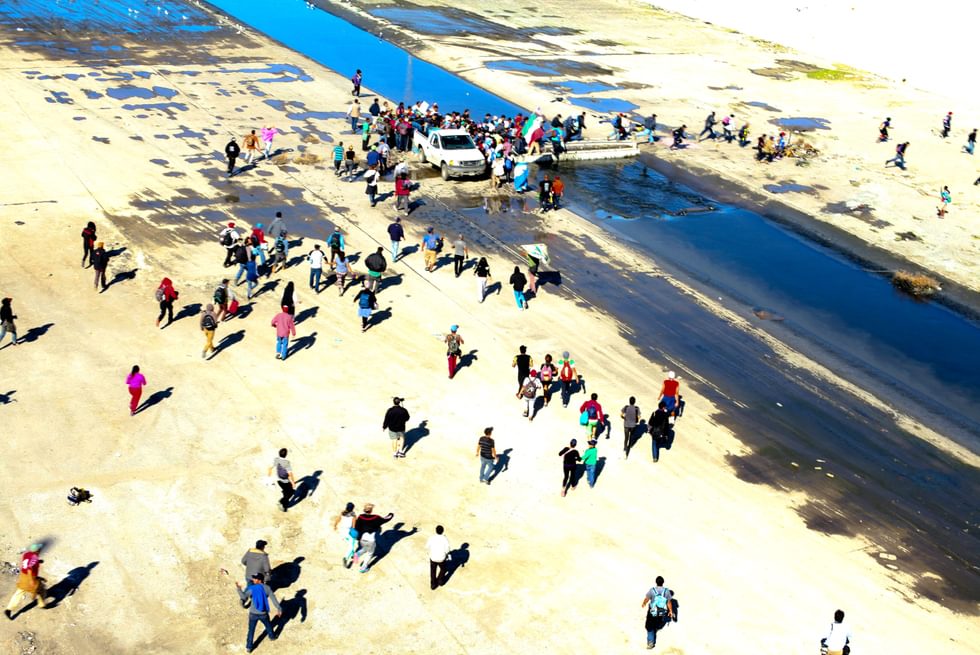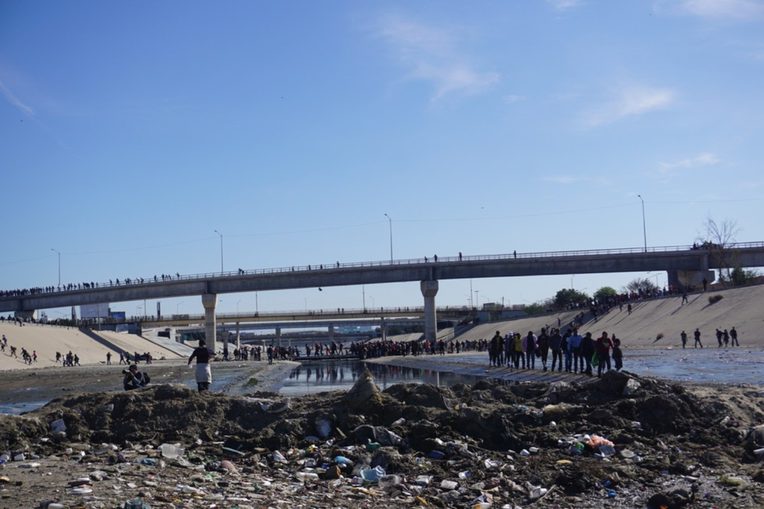The Caravan is Honduras: Hope and Death at the Border
From the Series: Behind the Migrant Caravan: Ethnographic Updates from Central America
From the Series: Behind the Migrant Caravan: Ethnographic Updates from Central America

“What do you think, you’re a gringa, will he let us in?”
“Honestly?” I reply, “I don’t think so, not as a group. My country isn’t very, um, friendly to migrants right now.”
“Yeah yeah, I know.” He shakes his head and then looks at me. “But you know what? Here’s the thing. For us, for Hondurans, now, life isn’t worth anything. We’ll get in. Sure, they’ll kill some of us. But we’ll get in.”
I had this conversation with César, an older Honduran, inside Benito Juarez, the small Tijuana baseball field turned temporary migrant encampment, a week or so after the largest migrant caravan in Mexican history had arrived. Just across the highway, a wall divides Mexico from California.
When a few hundred people gathered at the bus terminal in San Pedro Sula, Honduras, on October 13, the idea was that, together, they could make it across Mexico without being deported by Mexican immigration officials or targeted for assault, kidnapping, and extortion. Caravans had gotten through in the past. As news of the plan spread, those few hundred swelled to more than seven thousand. Some scrambled to join before the caravan left Honduras; others, already in Mexico, waited for it where they were. It seemed the safest, surest way to get to the northern border.
At moments, the caravan seems like a carnival. In Benito Juarez, a woman makes baleadas. Reggaeton blares. Groups of men play cards. Kids run and play, darting and weaving among the haphazard organization of tents and tarps. Babies have been born during the caravan; couples have gotten married. But this jovial atmosphere belies a darkness. At least seven Hondurans have died during this odyssey.
Death has been at the heart of the caravan since before it coalesced. A Mexican activist put it succinctly: the caravan’s real organizers are death and hunger. Pretty much everyone I know in San Pedro Sula knows someone who has been murdered. It comes up casually in nearly every conversation. We will be talking about something else and then, mataron a mi tío, mi primo, estuve ahí cuando acribillaron al pulpero. They killed my uncle, my cousin. I was there when they gunned down the store owner. Saúl tells me he joined the caravan because there is not enough work. Later, he mentions that his father had been killed.
César’s words: in Honduras, life isn’t worth anything. It’s a common refrain, yet a clumsy translation. It’s not that life is not valued; rather, it is that violent death is too familiar. People know, painfully, unflinchingly, that their lives are not valued. They don’t expect to be protected in life or mourned in death by their government, to say nothing of Mexico’s or that of the United States.
And yet here they are, up against the most powerful military on the planet, asking, demanding, hoping to be let in. Migration in this context is an extraordinary leap of faith, mixed with a sober recognition that not everyone will make it.
One Sunday, a few hundred caravaneros march, signs held high, toward the pedestrian crossing point. Still far from the border, Mexican police block them. The caravanerosstop. They ask to negotiate. They sing the Honduran national anthem. They thank Mexico. They pray.
The police are not moved.

People split off, no one sure where to go, sights set on the checkpoint. They cross a canal bed sticky and muddy with sewage sludge. People change routes, jump fences. A few throw stones. Some try to climb the wall. The only ones using real force, however, are the U.S. Border Patrol and police. When one group nears the fence, the uniformed officers fire tear gas and rubber bullets. That group disperses. Back on the other side of the canal, in Mexican territory, they fire again. This time, they hit people.
The day after Hondurans were teargassed by Americans on Mexican soil, Hondurans were teargassed by their own government in their capital city. On the anniversary of a likely fraudulent election that installed Juan Orlando Hernandez in an unconstitutional second term as president, Hondurans took to the streets. Here, too, they were met with tear gas and live rounds.
Many caravaneros left Honduras not because of criminal violence, but because they are opposition activists. Armando, twenty-two years old and a leader of the student movement known as MEU, was in hiding. After hearing about the caravan, he organized a contingent. Jairo, an economics student, was too recent an arrival to be fully involved in MEU, but he participated in marches. He has since discovered he is on a (black) list. Political threats mixed with gang threats—the caravan was his chance to flee. Both made it out alive, but at least sixteen people were killed by security forces during the postelection protests.
One week later I am back to fieldwork in San Pedro Sula. Today, Doris is frazzled. The night before, police stormed her house, looking for her sons. Why? Because when they saw the police truck coming they ran. One officer says: good thing we didn’t find them. We’d have killed them.
“This is why we tell our kids to leave!” Doris tells me. “They run when they see the police because we all know too many kids who have been picked up only to be found dead the next day. It hurts us, but this is why, sometimes, we tell our sons to go.”
Later, I get a message from Ani, with the caravan in Tijuana. I tell her I’m just leaving her neighborhood. Half gasp, half laughter, she replies: Ay, Amelia, I can’t even enter there.
Borders are everywhere. For people like Ani, the wall in Tijuana is less fear-inducing than San Pedro’s invisible borders. Crossing those means death. Crossing the U.S. border only might mean trauma, incarceration, or worse. But it might also mean breathing easier, a future less filled with loss.
“¿Qué opina, Ud. es gringa? ¿Nos deja entrar?”
“¿Honestamente?” contesto, “no creo, no como un grupo. Mi país no está muy . . . amigable con los migrantes ahora.”
“Sí, sí. Lo sé,” Agacha la cabeza un momento y me mira. “¿Pero sabe qué? Así está la cosa. Para nosotros los hondureños, ahora, la vida no vale nada. Vamos a entrar. Sí, nos van a matar a algunos. Pero vamos a entrar.”
Conversamos con César, un señor hondureño, en la cancha de béisbol Benito Juárez convertido en albergue temporal para migrantes en Tijuana, aproximadamente una semana después de que la caravana más grande de la historia de México había llegado ahí. Al otro lado de la carretera, el muro separa México de California.
El 13 de octubre, cuando unos cientos de personas se juntaron en la terminal de autobuses de San Pedro Sula, la idea fue que así—juntos— podrían atravesar México sin ser ni deportados por la migra mexicana ni estar expuestos al asalto, el secuestro y la extorsión. En el pasado, las caravanas han funcionado. Conforme corrió la noticia, esos cientos se convirtieron en más de 7000. Algunos se apuraron para unirse antes de que saliera la caravana de Honduras; otros, ya en México, esperaban ahí. Parecía la manera más segura de llegar a la frontera norte.
Por momentos, la caravana parece carnaval. En Benito Juárez, una mujer prepara baleadas. Reggaetón suena. Hombres juegan a los naipes. Niños corretean entre el arreglo caótico de carpas y lonas. Nacieron bebés en la caravana, se celebraron matrimonios. Pero esta atmósfera jovial también oculta una oscuridad. Al menos siete hondureños han muerto durante esta odisea.
La muerte es parte de la caravana desde antes que se consolidara. Un activista mexicano lo dijo claro: el verdadero organizador es la muerte y el hambre. Casi todas las personas quien conozco en San Pedro Sula conocen a alguien que fue asesinado. Surge, casualmente, en casi todas las conversaciones. Hablamos de otro tema y, luego, mataron a mi tío, a mi primo, estuve ahí cuando acribillaron al pulpero. Saúl me cuenta que se unió a la caravana porque no hay trabajo. Luego menciona que mataron a su padre.
Las palabras de César: en Honduras la vida no vale nada. Es un refrán común. No es que no se valore la vida; es que la muerte violenta es demasiado conocida. La gente sabe, dolorosamente, impávidamente, que sus vidas no son valoradas. No esperan ser protegidos en vida ni llorados en muerte por su gobierno, mucho menos por el de México o de los Estados Unidos.
Y, sin embargo, aquí están, enfrentándose con las fuerzas armadas más poderosas del planeta, pidiendo, exigiendo, esperando que los dejan entrar. La migración, en este contexto, es un acto extraordinario de fe y una resignación sobría de que no todos lo van a lograr.
Un domingo, cientos de caravaneros marchan, con pancartas, hacia el puerto fronterizo peatonal. Lejos de la frontera, la policía mexicana los bloquea. Los caravaneros se detienen. Piden negociar. Cantan el himno nacional de Honduras. Agradecen a México. Oran.
La policía no se (con)mueve.

La gente se dispersa, nadie seguro de a dónde ir, pero con la vista siempre fija en la garita. Cruzan un canal lodoso de aguas negras. Cambian de ruta, brincan vallas. Algunos tiran piedras. Otros intentan trepar el muro. Los únicos que utilizan la fuerza, sin embargo, son la patrulla fronteriza estadounidense y la policía. Cuando un grupo de migrantes se acerca al muro, oficiales uniformados lanzan gases lacrimógenos y balas de goma. Ese grupo se desintegra. Al otro lado del canal, en territorio mexicano, vuelvan a disparar. Esta vez, pegan a la gente.
Al día siguiente de cuando hondureños son gaseados por estadounidenses en territorio mexicano, hondureños también fueron gaseados por su gobierno en su capital. A un año de la probablemente fraudulenta elección presidencial que colocó a Juan Orlando Hernández en un segundo periodo inconstitucional, los hondureños tomaron las calles. Aqui también la respuesta fue gases lacrimógenos y balas vivas.
Varios caravaneros abandonaron Honduras no por la violencia criminal, sino porque son activistas de la oposición. Armando, de veintidós años y líder del Movimiento Estudiantil Universitario (MEU) tuvo que permanecer en la clandestinidad. Supo de la caravana, organizó un contingente. Jairo, estudiante de economía, fue muy nuevo para ser miembro de MEU, pero participaba en las marchas. Luego, se enteró de que su nombre figura en una lista negra. Amenazas políticas se entretejen con amenazas de pandillas. La caravana fue su oportunidad para huir. Ambos jóvenes lograron salir vivos. Un mínimo de dieciséis personas fueron asesinadas por las fuerzas de seguridad durante las manifestaciones post-electorales.
Una semana después, estoy de vuelta al trabajo de campo en San Pedro Sula. Hoy, Doris esta agitada. La noche anterior, la policía se metieron a su casa, buscando a sus hijos. ¿Por qué? Porque cuando ellos vieron venir la patrulla, corrieron. Un oficial le dice, mejor que no los encontramos. Los hubiéramos matado.
“¡Por eso les decimos a nuestros hijos que se vayan!” me comenta Doris. “Huyen cuando ven la patrulla porque todos sabemos de muchos guirros que fueron detenidos por la policía y aparecen muertos al día siguiente. Nos duele, pero eso es porque, a veces, les decimos a nuestros hijos que se vayan.”
Después, Ani, en Tijuana con la caravana, me envía un mensaje. Le respondo que estoy justo saliendo de su colonia. Entre jadeos y risas, me contesta, Ay Amelia, ni siquiera yo puedo entrar ahí.
Las fronteras están por todas partes. Para personas como Ani, el muro en Tijuana infunde menos miedo que las fronteras invisibles de San Pedro Sula. Cruzando aquellos significa la muerte. Cruzar la frontera estadounidense podría implicar trauma, encarcelamiento, o peor. Pero podría, también, implicar poder respirar más tranquilamente, un futuro con menos plagado de dolor.